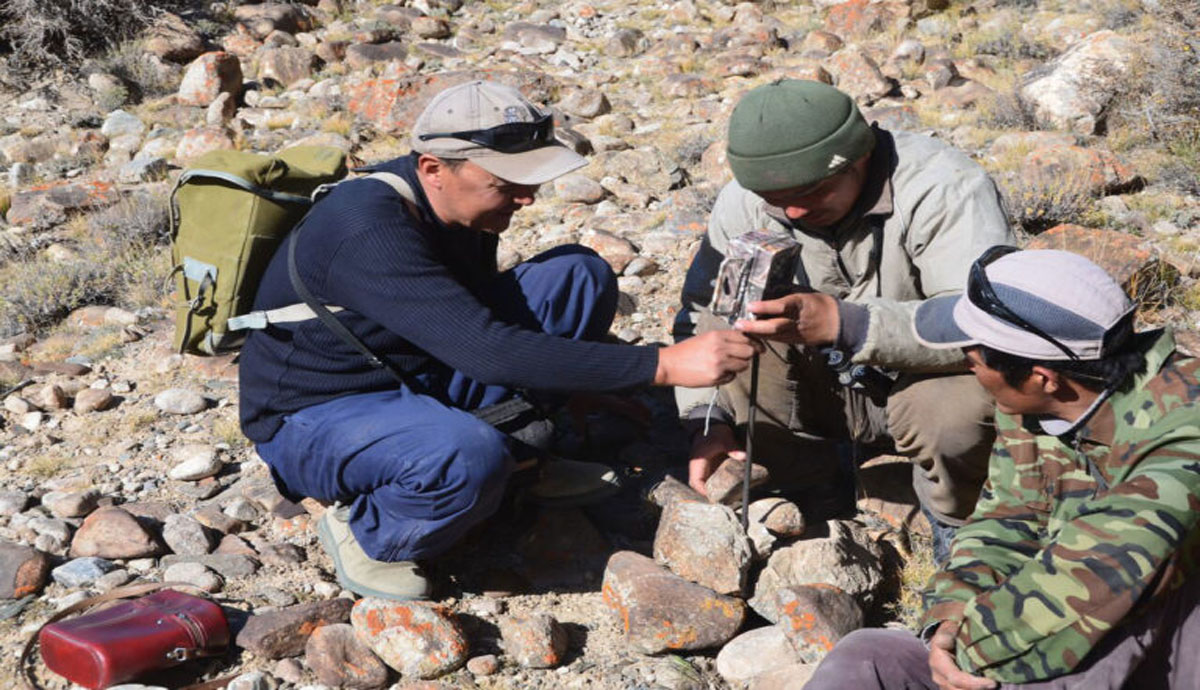Tajikistan: Pamir Alay & Tien Shan

| PROJECT TITLE | Conservation and Sustainable Use of Pamir Alay and Tien Shan Ecosystems for Snow Leopard Protection and Sustainable Community Livelihoods. |
|---|---|
| COUNTRY | Tajikistan |
| EXECUTING PARTNER | National Biodiversity and Biosafety Centre |
| PROJECT PERIOD | 2016-2021 |
| GEF FUNDING | $4,181,370 |
| CO-FINANCING | $19,610,000 |
SCIENTIFIC RESEARCH
For the most part, snow leopards prefer to be alone. They choose solitude over companionship to such an extent that there is currently no term for a group of snow leopards. The physical features of these notoriously elusive animals are finely adapted to their surrounding environment. This enables these apex predators to seamlessly blend into rocky ravines and stealthily hunt their prey. These behavioral and physical attributes, combined with the vast expanses, remoteness and inaccessibility of the mountain ranges that they inhabit, make studying and understanding these animals extremely challenging. As a result, much about snow leopards remains unknown.
The paucity of scientific data on snow leopard ecology presents a significant impediment to designing and implementing effective conservation strategies. Many of the 12 snow leopard range countries face significant research, financial and technical capacity constraints. In one of those range countries, Tajikistan, snow leopards inhabit some 85,700 km. of the land, yet only rough estimates of their population numbers are available.
To address some of these issues, a new project will work in five key snow leopard habitats: Kuraminsky-West-Tien Shan; Hissar-Alai; Vakhsh Darvaz; Badakhshan; and Pamir, simultaneously implementing several strategic interventions. One of these will be to focus on strengthening snow leopard research, monitoring and planning, and building institutional capacities, resources and partnerships.
Several organizations currently undertake monitoring activities in Tajikistan. But these are usually localized, ad hoc efforts that generate highly fragmented data, stored in multiple, at times incompatible, formats. This information is not collated or actively maintained in a centralized database. To remedy these weaknesses, the government, in close consultation with the National Biodiversity and Biosafety Centre, the Academy of Sciences, the Forestry Agency and Panthera, will develop, implement and maintain a consolidated national snow leopard monitoring and reporting system and an information management system based on standardized collection procedures and criteria. Both systems will be integrated into Tajikistan’s broader Environmental Information Management and Monitoring System currently under development by another UNDP-GEF project.
To improve data collection, this project will increase the coverage of camera traps, establish a linked database for individual cat identification, and conduct aerial surveys of snow leopards and their prey across their entire range in Tajikistan. The use of radio collars and GPS satellite technology will improve knowledge of movement patterns, habitat use, home range size and dispersal. As a final step, the cost-effectiveness of monitoring snow leopard populations using fecal DNA analysis will be evaluated in a pilot study area.
To build institutional capacity, the project will host a series of specialist training sessions for researchers, scientists, academics, volunteers, students, NGO staff and government field staff. Trainings will focus on the monitoring and reporting system, information management system, monitoring tools and techniques, procedures and standards for collecting and submitting information, and relevant statistical tools and methods.
Relevant, high-quality and science-based information is required to guide snow leopard management efforts, effectively allocate scarce conservation resources and measure progress. Through this project, the government and its partners hope to establish reliable baseline data to track the effectiveness of snow leopard conservation programmes, identify priority areas for intervention, and facilitate strategic planning, decision-making and adaptive management for the future of Tajikistan’s snow leopards and high mountain ecosystems.


